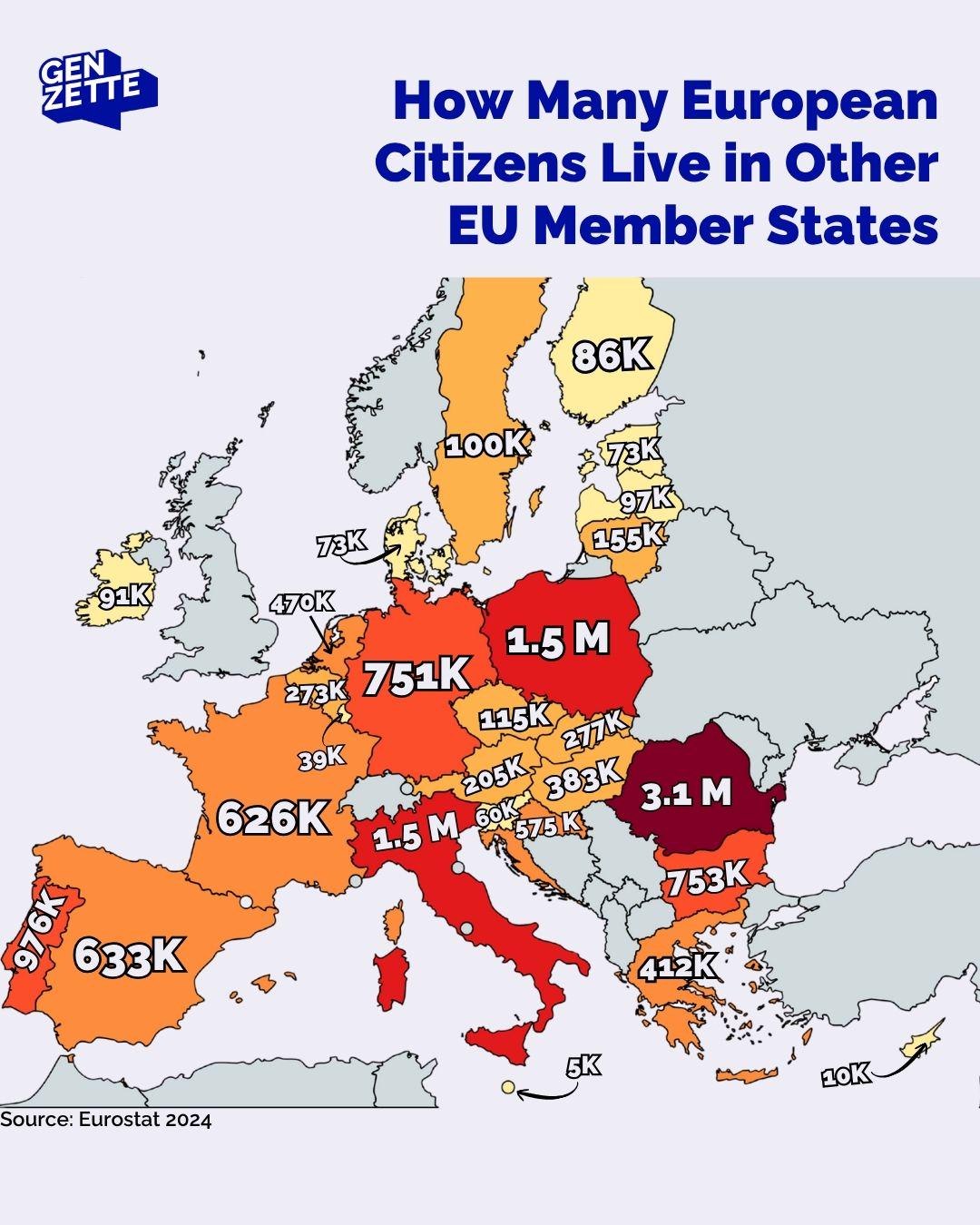Map of European Citizens Living in Other EU States


David Chen
Data Visualization Specialist
David Chen is an expert in transforming complex geographic datasets into compelling visual narratives. He combines his background in computer science ...
Geographic Analysis
What This Map Shows
This informative map provides a visual representation of the number of European Union (EU) citizens residing in other EU member states. It highlights the mobility of individuals within the European Union, showing how many people have chosen to live outside their home countries. The data, which encompasses various demographics and nationalities, reflects the interconnectedness of EU member states and the freedom of movement that is a cornerstone of the EU’s policies.
Deep Dive into EU Citizen Mobility
The movement of citizens within the EU is a significant aspect of European identity and culture. Ever wondered why so many Europeans choose to live in another EU country? There are numerous factors at play. With the establishment of the EU, barriers to movement have significantly decreased, allowing citizens to seek opportunities for work, education, and lifestyle changes in other member states.
According to recent statistics, approximately 10 million EU citizens reside in a member state other than their own. For instance, many citizens from Eastern European countries, such as Poland and Romania, migrate to Western European nations like Germany and the UK in search of better job prospects. This trend can be attributed to economic disparities, with wealthier countries offering higher wages and improved living conditions.
Interestingly, this geographical mobility isn't one-sided. Countries like Spain and Italy also attract large numbers of expatriates, including those from the UK, Germany, and France, who are drawn to warmer climates and vibrant cultures. The allure of a new life, often enhanced by the ability to work or retire in a sunnier locale, is a powerful motivator.
The demographic data is also revealing. Younger individuals, particularly those in their 20s and 30s, make up a significant portion of this mobile population. They are often pursuing higher education or starting their careers, taking advantage of the EU’s educational programs like Erasmus+. This program allows students to study abroad, fostering a sense of European citizenship and cultural exchange.
Moreover, the growing trend of remote work has further contributed to this phenomenon. With the rise of digital nomadism, professionals are now able to work from anywhere in the EU, blurring the lines of traditional residency. As a result, countries that were once primarily destinations for labor migration are now experiencing an influx of remote workers looking for a better quality of life.
Regional Analysis
Examining the map, one can see distinct patterns of migration across the EU. Northern and Western Europe, particularly countries like Germany, the Netherlands, and the Scandinavian nations, show high numbers of incoming EU citizens. For instance, Germany alone has over 2 million Polish residents, which highlights its role as a primary destination for those seeking economic opportunities.
Conversely, Southern European countries, including Italy and Spain, are notable for their appeal to expatriates from Northern Europe. The map may illustrate that the UK, despite its exit from the EU, continues to host a considerable number of EU citizens. This reflects historical migration patterns and ongoing familial ties that transcend political boundaries.
Eastern European countries, while experiencing significant emigration, are also seeing a slow but steady return of their citizens as economies improve and job opportunities arise. For example, Bulgaria and Romania have seen a gradual increase in their populations as economic conditions stabilize and opportunities for employment expand.
Significance and Impact
Understanding the mobility of EU citizens is crucial for several reasons. It sheds light on economic trends, cultural exchanges, and the social fabric of Europe. With Brexit still affecting migration patterns, it's essential to monitor how these shifts influence both the countries of origin and destination.
Moreover, the implications of this mobility extend beyond mere numbers. It impacts local economies, job markets, and social services in host countries, while also influencing cultural diversity and integration policies. As more EU citizens live and work in different countries, cities become increasingly multicultural, fostering innovation and collaboration.
Looking ahead, the future of EU mobility remains dynamic. With ongoing debates about immigration policies and labor markets, it's vital to stay informed about how these changes will shape the landscape of Europe. The trend toward remote work is likely to continue, indicating that the movement of citizens within the EU will evolve further, impacting how we view residency and citizenship in a globalized world.
Visualization Details
- Published
- August 8, 2025
- Views
- 94
Comments
Loading comments...